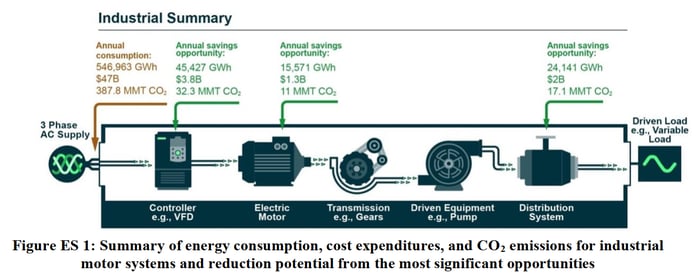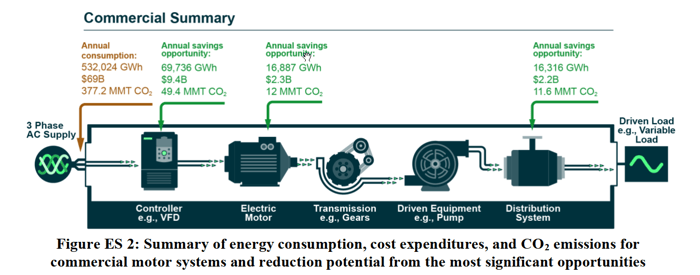In 2016, the U.S. Department of Energy initiated a Motor System Market Assessment (MSMA), led by Lawrence Berkeley National Laboratory, to study the enormous base of electric motors in the U.S. Five years later, they released the first of three volumes of a report summarizing and analyzing the MSMA. Volume 1 summarized key attributes of the motors in use in the industrial and commercial sectors. We talked about Volume 1 back in May and June 2021. Later, Volume 2 assessed the motor and drive supply chain. Finally, in July of 2022, the long-awaited Volume 3 was released, covering potential energy savings from various changes to motor systems.
Changes to Motor Systems That Increase Energy Savings
The report identified three major areas of opportunity:
- Improved load matching: For constant loads, this would be replacing oversized motors with smaller ones. For variable loads, it would mean adopting variable frequency drives (VFDs) to control the motors' speed/torque. As mentioned in Part 1 of the report, only 16% of industrial motor systems, and 4% of commercial, currently use drives.
- Motor upgrades: Many motors in current use could be replaced by newer, more energy-efficient models.
- Improving the condition of fluid distribution systems: Repair and efficiency upgrades to air, water, coolant, and other fluid distribution systems.
The report also explored a fourth category, emerging or advanced technologies, like permanent magnet and switched reluctance motor topologies.
Improved Load Matching for Industrial and Commercial Systems
In this blog post, we will be mainly interested in the improved load matching category, which offers the largest savings for both industrial and commercial systems, as shown below. Out of the 547 TWh (1 TW = 1000 GW) used annually by industrial motor systems, it is estimated that 45 TWh (8.2%, worth $3.2 billion) could be saved by better load matching. For commercial systems, 69 TWh (worth $9.4 billion) could be saved, 13% of the total 532 TWh used per year. (Click the images to enlarge.)


As shown, lesser amounts could be saved by motor upgrades and fluid distribution systems. The former makes the bigger difference in the commercial sphere; the latter in industrial. In this post, we will focus on load matching, the largest source of savings in both use categories.
Limitations
Before going on, it is appropriate to mention some limitations of this research. Firstly, it neglected motors under 1 hp, which make a doubly small contribution to total energy use because of both their small consumption and small population. Secondly, it did not consider interactions between the savings opportunities. For instance, premium efficiency motors have lower slip, and the higher resulting speeds may exacerbate other inefficiencies. (Incidentally, this can be compensated for when the motor is on a drive - another interaction!)
For another example, suppose a motor driving a variable load was put under VFD control. If the motor was not suitable for inverter control, it could be subject to winding and bearing damage and premature failure, introducing additional cost (of repair or replacement) and possibly unplanned downtime, cutting into the monetary savings. If, on the other hand, when the drive was introduced, the motor was replaced with a high-efficiency inverter-ready motor (with shaft grounding, of course), the larger upfront investment would reliably pay off in savings from load matching and motor efficiency upgrade.
Looking at the Cost-Effectiveness of the Proposed Changes
The idea of an upgrade to one part of the system causes failure in another leads to our final point: Just how cost-effective are the changes proposed? To assess this, the report's authors compared the calculated payback period in years (cost of installation divided by the change in annual operating costs before and after installation) and compared it to the respondent facilities' maximum acceptable payback period. The following graph shows the cost-effectiveness of adopting VFD control for variable load systems.
 At current prices, VFD control is cost-effective for 45% of eligible commercial systems, and for 74% of eligible industrial systems. (Salmon bars - the other bars show what would be considered cost-effective if the price of drives decreased.) It is interesting that the percentage of cost-effective savings is so much lower for commercial applications. Part of the difference is that industrial motors are larger on average, and drives have a lower $/hp cost at higher power (e.g., one 20 hp drive costs less than two 10 hp drives). The bottom line is, at 2021 prices, both industrial and commercial systems could save over 30 GWh per year. At average prices of $0.086 (industrial) and $0.13 /kWh (commercial), that means savings of $2.8 and $4.0 billion. If concerned companies adopted longer acceptable payback times, even more staggering savings would be possible, simply from adopting drive control for variable load systems.
At current prices, VFD control is cost-effective for 45% of eligible commercial systems, and for 74% of eligible industrial systems. (Salmon bars - the other bars show what would be considered cost-effective if the price of drives decreased.) It is interesting that the percentage of cost-effective savings is so much lower for commercial applications. Part of the difference is that industrial motors are larger on average, and drives have a lower $/hp cost at higher power (e.g., one 20 hp drive costs less than two 10 hp drives). The bottom line is, at 2021 prices, both industrial and commercial systems could save over 30 GWh per year. At average prices of $0.086 (industrial) and $0.13 /kWh (commercial), that means savings of $2.8 and $4.0 billion. If concerned companies adopted longer acceptable payback times, even more staggering savings would be possible, simply from adopting drive control for variable load systems.
Of course, energy savings are energy savings, but monetary savings can be wiped out by downtime and repair costs. So facility managers would be well advised to ensure that motors put under drive control are resistant to destructive side effects of VFDs. That is, inverter duty motors with robust winding insulation to resist damage from high dV/dt, and reliable shaft grounding like AEGIS® rings to prevent electrical bearing damage.
This blog post has barely scratched the surface of Volume 3 of LBNL's report on the MSMA. If you are interested, we urge you to give it a read. You might find ideas that can help your own facility save money, or find potential pitfalls in a plan you're currently working on.
AEGIS Shaft Grounding Rings have a 2-year extended warranty against bearing fluting damage. No other form of shaft grounding offers a warranty like this.
To learn more about AEGIS shaft grounding and best practices for electrical bearing protection, sign up for a training. We offer monthly live training webinars, and – pandemic restrictions permitting – we can also visit your facility to review your exact application.



